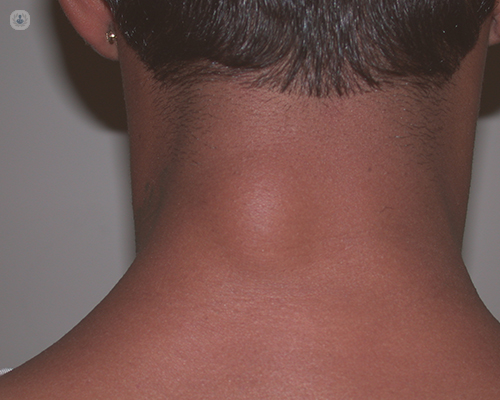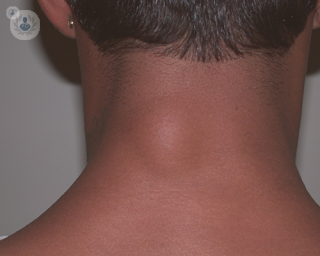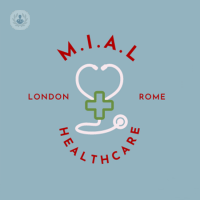Lipoma
What is a lipoma?
A lipoma is a benign lump that forms under the skin, often made from overgrown fatty tissue. They usually grow slowly over several months and can develop anywhere on the body, situated between the skin layer and the muscle layer beneath.
These lumps are usually painless and can appear on the upper back, shoulders, chest, abdomen, arms, thighs, bottom and the back of the neck. Their firmness can also vary, from soft to hard.
Some people may have multiple lipomas in different locations of the body.

What are the different types of lipomas?
All lipomas are made up of fat, but some also contain blood vessels or tissue. There are different types depending on how they appear under the microscope, of which the most common ones are:
- Conventional lipoma: the most common type of lipoma, they are growths of white fat that is painless and moveable beneath the skin.
- Hibernoma: the only type of lipoma that is made up of brown fat.
- Fibrolipoma: growths that are a mixture of fat and fibrous tissue which are frequently formed throughout the gastrointestinal tract and in and around the mouth.
- Angiolipoma: multiple growths of fat and large amounts of blood vessels which are usually painful.
- Myelolipoma: the rarest type of lipoma, they are growths of fat and the tissue responsible for making blood cells.
- Spindle cell lipoma: growths of fat and long cells that form on the back, neck and shoulders.
- Pleomorphic lipoma: growth of fat and cells of different shapes and sizes, they are usually found on the neck and the back.
What causes a lipoma?
The cause of lipomas is unknown. It is believed that they may be genetic, so if your parents or other members of the family had lipomas, then you may also be prone to developing them. They can often appear after an injury, though the reason they form is unknown.
What are the symptoms of a lipoma?
As previously mentioned, lipomas are usually painless, though can cause some pain if they press on nearby nerves.
They appear as soft, doughy lumps ranging in size from around the size of a pea to as big as a grapefruit. The lumps may move slightly if pressed.
Seek medical attention if a lipoma increases in size, becomes painful, hard or unmovable. This may indicate that the lipoma is changing.
For the most part, a lipoma is not a serious condition, but any lump or swelling that appears on the body should be checked regardless, to rule out other possible causes.
Who is more at risk of developing lipomas?
Lipomas are common. Although people of any age can develop lipomas, they are more prevalent in adults between 40 and 60 years of age.
People with the following conditions are more at risk of developing one or more lipomas:
Unfortunately, lipomas can't be prevented.
How are lipomas diagnosed?
A physical exam is necessary to diagnose lipomas and differentiate them from cysts or fibroids. Besides a physical examination, your doctor may perform a biopsy (procedure to remove a small sample of tissue) to find out the characteristics of the tissue.
An MRI or a CT scan may also be ordered to find out the exact location of the lipoma if liposarcoma (a cancerous tumour type) is suspected, if the lipoma is large, if the lipoma appears to be attached to deep skin structures or if the lipoma has unusual features.
What is the treatment for lipomas?
Lipomas don’t usually cause any problems if left alone, however they can be treated if required.
The most common way of treating lipomas is to have them surgically removed. Possible side effects include scarring, bruising and infection after the operation.
Surgery involves making an incision to remove the fatty tissue, before suturing the opening. Though there is a risk that the lipoma may return, it is uncommon.
Another treatment option to reduce the size of the lipoma is liposuction, where a needle is used to remove some of the fat from within the lipoma.
Finally, steroid injections may be used to treat the lipoma. The steroid injection works to shrink the lipoma, though this treatment doesn’t completely remove the lipoma.
Will a lipoma grow back after treatment?
Lipomas that are completely removed don't tend to return, but if some of the original lipoma was left behind (for example, if it had infiltrated the muscles or if it was located in a sensitive area), another lipoma can develop in a different spot on your body. Recurring lipomas aren't dangerous and will have the same characteristics of any other lipoma.
Lipomas that return usually occur in people who have risk factors for lipomas. Even if they return, lipomas can be removed and treated again in the same way.
Which type of specialist treats lipomas?
A dermatologist will examine the lipoma and decide if it requires treatment. If treatment is necessary, the dermatologist will work alongside a surgeon, possibly a plastic surgeon, to remove the lipoma.
Can lipomas become cancerous?
Lipomas aren't cancerous and they have very little potential of becoming cancerous over time.
Can lipomas cause back pain?
Painful fatty lumps in the sacroiliac area (the joints connecting the pelvis to the lower spine), commonly called 'back mice', can be a frequent cause of pain in the lower back. 'Back mice' are usually associated with lipomas, but they can also involve other conditions including episacral lipoma, lumbar fat herniation, iliac crest pain syndrome, sebaceous cyst, subcutaneous excess, liposarcoma and sciatica.
Lipomas and pregnancy
Surgery to treat lipomas isn't usually recommended for women who are pregnant or who are breastfeeding as the procedure may pose a risk to the health of the mother and the baby. However, removal may be done if it is deemed medically necessary, after a consultation with an obstetrician and a dermatologist.
Having lipomas or having had them in the past, doesn't affect fertility.















